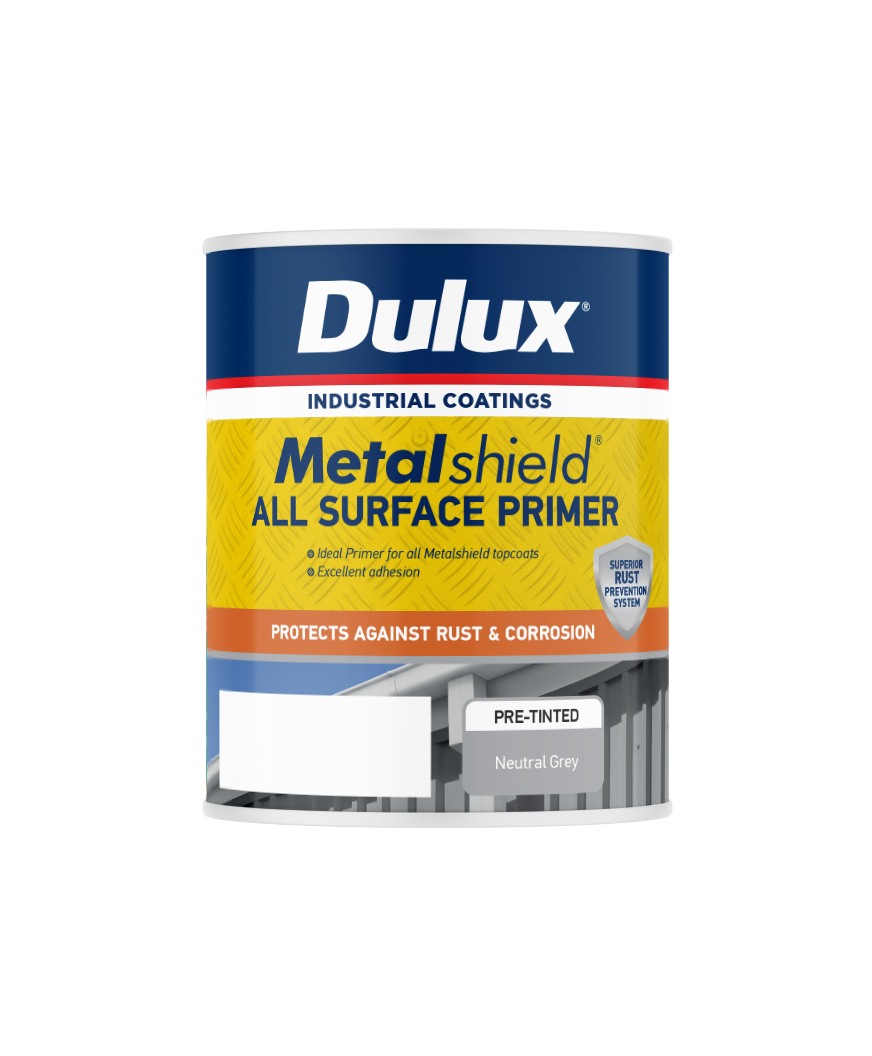Metalshield® All Surface Primer

About Metalshield® All Surface Primer
Dulux Metalshield® All Surface Primer is a high performance metal protection primer suitable for priming mild steel, aluminium, galvanised steel and fibreglass.
Downloads
Application
At a glance
- Formulated with zinc phosphate for superior metal protection
- Fast drying
- Available in 500ml, 1L, 4L
- Available in Grey base
- Ideal primer for compatible Metalshield topcoats on a wide range of metal substrates
Areas to use
Surfaces
Ideal primer for compatible Metalshield topcoats on a wide range of metal substrates.
• Bare steel
• Wrought iron
• Galvanised iron
• ZINCALUME®
• Aluminium
• Copper
• Brass
• Stainless Steel
• Metal
Previously Painted Surfaces
Ensure the surface has thoroughly dried prior to application.
Aged/lightly rusted surfaces:
• Remove any rust by scraping, sanding or wire brushing.
• Wipe surface with acetone to remove any residual grease, oils and dirt.
Bare steel, wrought iron:
• Wipe surface with acetone to remove any residual grease, oils and dirt.
Galvanised iron, ZINCALUME®, aluminium, copper, brass, stainless steel:
• Clean surface with mild detergent and a Scotch-Brite® Pad to remove any grease, oils and dirt.
• Rinse with clean water.
Commercial applications may require additional surface preparation.
Brush, roller
• Stir contents thoroughly with a broad flat stirrer using a stirring, lifting action.
• No thinning is required for brush or roller application.
• Stir well prior to applying one coat of Dulux Metalshield® All Surface Primer by brush, roller or spray.
• For best results, apply the primer immediately after the surface preparation is complete.
• Application and drying temperatures must be above 10°C.
Airless/Conventional Spray
• Stir contents thoroughly with a broad flat stirrer using a stirring, lifting action.
• For spraying, thin up to 150ml per litre with acetone or Dulux Urethane Thinner
• Stir well prior to applying one coat of Dulux Metalshield® All Surface Primer by brush, roller or spray.
• For best results, apply the primer immediately after the surface preparation is complete.
• Application and drying temperatures must be above 10°C.
Unused paint
Do not pour leftover paint down the drain.
Unwanted paint should be brushed out on newspaper and allowed to dry, and then disposed of via domestic waste collections.
For more information on responsible disposal of paint and packaging visit painttakeback.co.nz or paintback.com.au.
Empty paint containers
Leave empty paint containers open in a well-ventilated area to dry out. When dry, recycle the container via steel can recycling programs.
Disposal of empty paint containers via domestic recycling programs may differ between local authorities. Check with your local council first.
Do not reuse container unless thoroughly decontaminated.
For more information on responsible disposal of paint and packaging visit paintback.com.au or painttakeback.co.nz
Make confident decisions about your project needs with support from our wide network of colour and product specialists, tools, programs and apps — or chat to one of our expert consultants now.

Imagining how a space will feel in a new colour scheme is hard. Save time and gain colour confidence the smart way with personal guidance from an expert Dulux Colour Consultant.
Learn more-->Our expert support team can help with everything from choosing colour, what product is the most appropriate for your job or troubleshooting when something hasn’t gone your way.
Find help and advice-->
